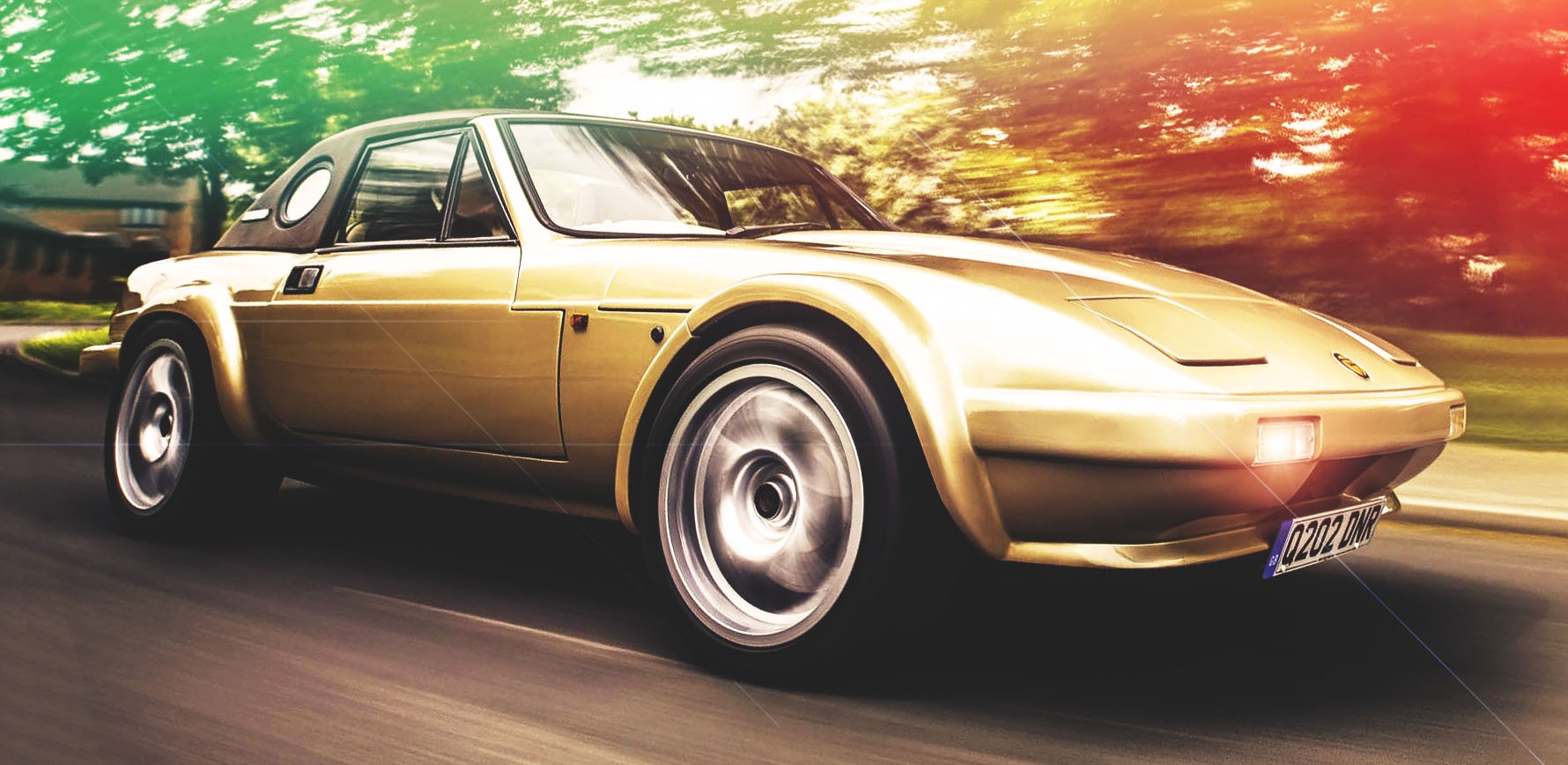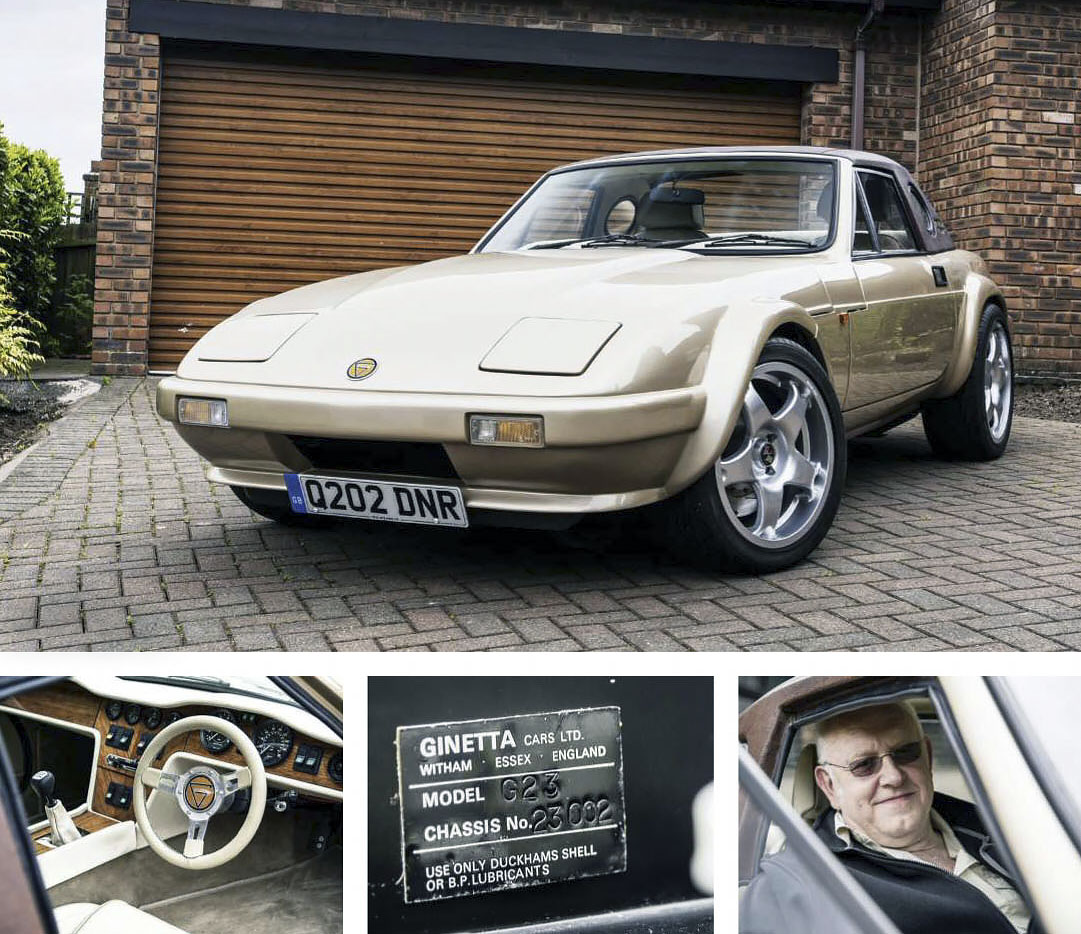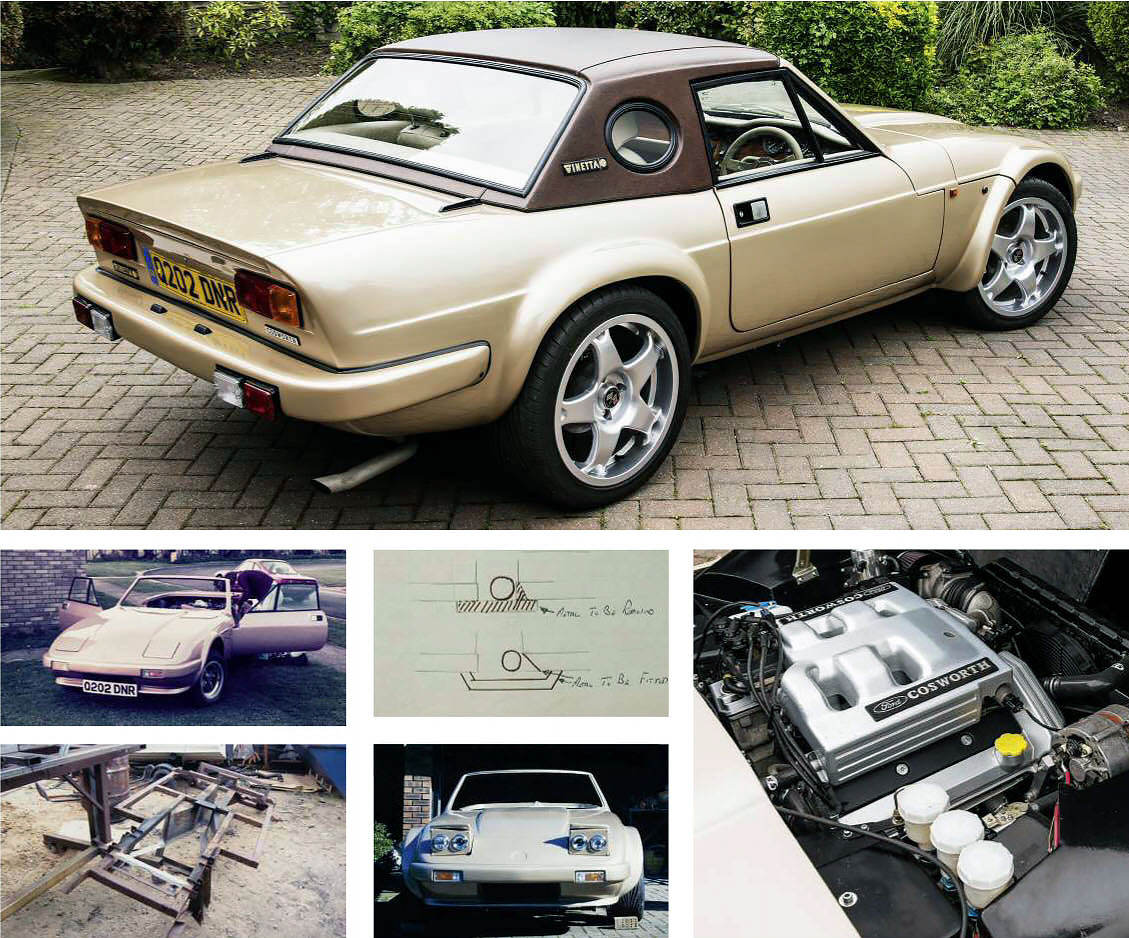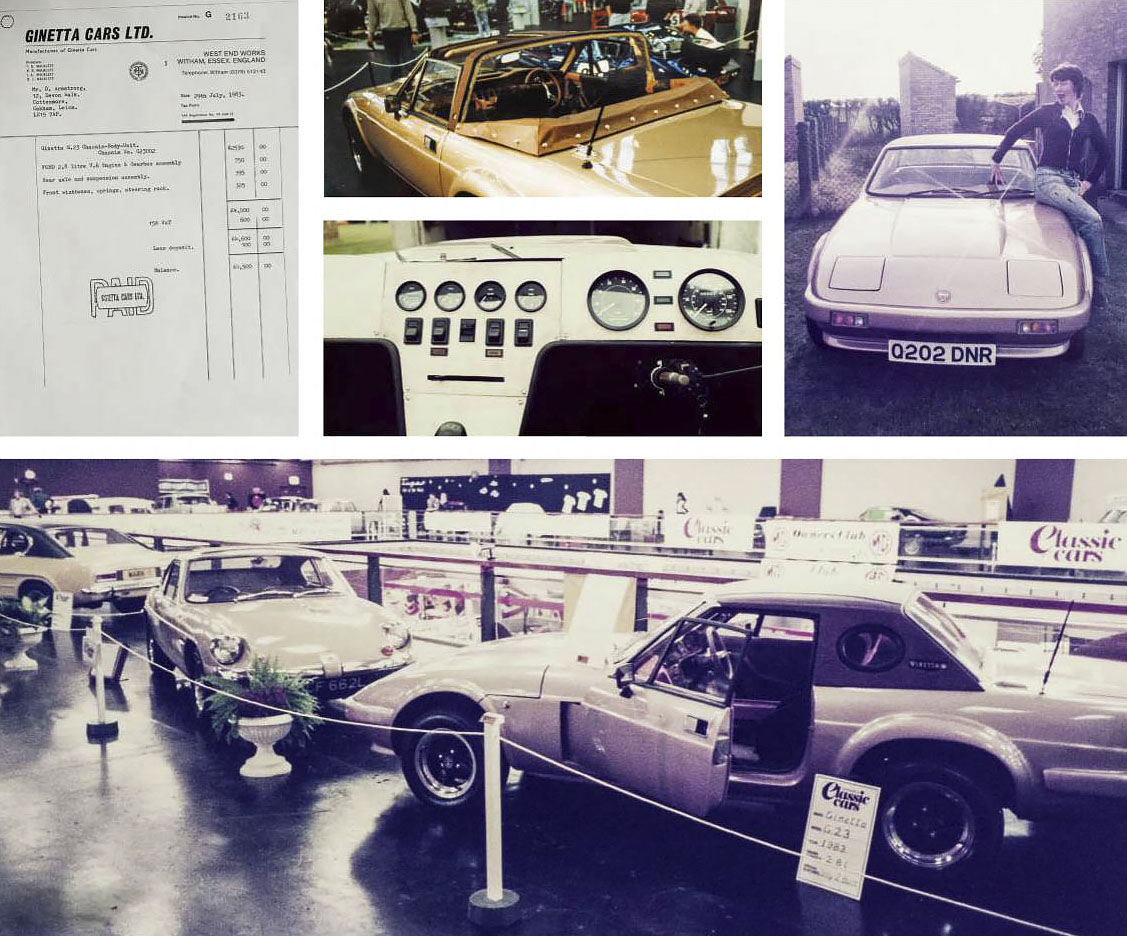
Life Cycle. The epic story of the Ginetta G23 concept car that should never have existed. This Ginetta G23 hits the road for the first time since 1993. A concept car never intended for the road, this Ginetta went from inanimate motor show model to one couple’s obsession. Words Sam Dawson. Photography Jonathan Jacob. Don fits the G23 with Triumph GT6 front suspension to move it from the Ginetta factory.
1981 The G23’s story seems to be over already
‘We had intended the G23 to be a V6-engined follow-on from the G21,’ says Ginetta co-founder Bob Walklett. ‘That Ford Cologne V6 was a fantastic engine – we built a special based around that V6 and took it to Brands Hatch, where Chris Meek beat Jaguars with it. We knew we had to use it after that, so we designed a car around it – the G23.
‘We built two in the end,’ he continues, ‘the running concept with Triumph independent rear suspension and this one, with a Ford live rear axle. However, we soon realised it could never be a production model because we had difficulty with parts supply. It wasn’t that Ford was difficult to work with – we always had a very good relationship with Ford, who supplied us with almost all our engines over the years.
However, Ginetta was always debt-free – a difficult task for a specialist manufacturer – and the key to that was ensuring we always paid our suppliers on time every month. Most don’t do that, racking up debts and causing the suppliers to charge more for their parts, which in turn gets passed on to the customers and makes the cars expensive.
‘We’d briefly used the Ford Essex V6 before, in a few G21s, but as Essex production was being brought to an end and the Cologne wasn’t in Ford’s UK range in 1981, the cost of importing the engines from Germany would have been too high to make the G23 viable, and would have made it difficult for us to avoid debt.
‘In the end it didn’t matter,’ adds Walklett. ‘I sold the Witham factory – leaving the half-built Ford-axled car behind – bought a new facility in Scunthorpe and launched a cost-effective new range based on British Ford parts. It was a marvellous era, but sadly the G23 couldn’t be part of it.’
1983 Enter Don and Sue Armstrong, who buy the G23 for £4500
‘We took our old G15 down to the Witham factory for a service in 1981, and saw the first G23 prototype – a blue car – sitting in the showroom,’ recalls Don Armstrong. ‘I said to Bob Walklett if he ever wanted to sell it, I was interested. A year later I was at a Ginetta club show at Santa Pod and saw it again, but they’d sold it. The owner said there was another car, slightly different, sat behind the factory with a Ford Capri live rear axle rather than the independent rear suspension the blue car had.
‘I went down to Witham, found it and bought it for £4500 from Bob Walklett – essentially brand-new, but it’d been sat in the yard for three years clearly unfinished – I had to fi t front suspension before I could move it. I was in the RAF at the time, and got it roadworthy enough to pass the MoT test in the machine shop at RAF Cottesmore. It was like a jigsaw with half the pieces missing, but I cobbled enough together – largely adapting Triumph GT6 suspension bits – to get it roadworthy by February 1984. Annoyingly it ended up with a Q-prefix registration number – 1983 was the first year of Q-plate legislation, and I don’t think the DVLA had really got to grips with it by this point. It should have been registered on an A-prefix plate, but the tester asked, “Does it have any secondhand parts?” I jokingly pointed out that the wiper motor came out of an old donor car – which was true – and his response was “Right, it gets a Q-plate then!” Frustratingly the only other example of the G23, the blue car, has a normal age-related registration, so no one calls it a kit car. Presumably it has a new wiper motor.’
1984 February The real £7827 rebuild gets under way
‘It was technically roadworthy, but very rough,’ recalls Don. ‘It was on steel wheels, the dashboard was a slab of acrylonitrile butadiene styrene (ABS) plastic, the drivetrain didn’t quite fi t the chassis properly and the paint was awful. ‘I took it to my local paint shop in Oakham, Rutland, and they said it would have to go back to bare glassfibre, but they obviously didn’t know much about painting composites so they poured paint stripper on it, completely ruining it.
‘We took it back and Sue got to work on it in the garage, flatting the gel coat back down and she repainted it in what turned out to be Volkswagen-Audi Pearl Beige – I was somewhat disappointed by the paintcode name, I thought it would be gold!
‘Sue also set about trimming the car. The architecture of the G23 is based around that of the old G21, which has a specially moulded ABS plastic dashboard, but Ginetta didn’t have any spares available so we had to make our own.
‘I tended to work on the mechanical bits, Sue on the structure, bodywork and trim, and anything we hadn’t got the skills to do we farmed out to professionals, but it seemed no one could make a proper veneered dashboard. Sue fashioned one out of marine ply, and veneered it with African rosewood in the back bedroom.’
Don digs out the book he compiled documenting the car’s first build. ‘I bought some Revolution wheels from Ginetta for £140, the sort that were being used on the GRS Tora estate, to replace the steels, and I had to reprofile the centre of the chassis to stop the propshaft from scraping on it. According to my calculations, the car had cost us £7827 by the end of the build.’
1984 June The Ginetta finally hits the classic show circuit
‘I took it down to Witham to show the Walklett brothers, and they took it for a drive down the Witham bypass,’ says Don. ‘I waited nervously to hear what they had to say after pulling up, and Bob just said, ‘Suspension’s too hard – Doug, get the man some softer springs.” Doug Walklett duly obliged, free of charge.
‘I ran it as a daily driver for nine years after the build – went shopping, went on holiday, drove Ginetta Club regalia round the country, even collected building materials in it,’ says Don. ‘But it did a lot of shows back then.
‘It made its debut post-build appearance in the August 1984 issue of Classic Cars, and was shown at the Brighton Metropole in October. It was hoisted onto the first floor in a lift, and I remember wandering down the seafront afterwards to look at the damage that had been done to the Grand Hotel by the IRA bomb.
‘We suspect the car was always meant to have a proper soft-top roof, but being a prototype they only bothered with a bolt-on hardtop,’ says Don. ‘In 1988 Sue went round various shows taking photos of T-bar-style roof structures, and took a glassfibre mould of the hardtop so that a canvas hood could be created. She based the roof design on the glassfibre T-bar structure of a JBA Javelin (a MkII/III Ford Capri convertible conversion), similar to a Triumph Stag’s but with two lift-out panels ahead of the crossbar.
‘It was funny finding parts for it back then. In 1989 the Walkletts sold the firm to Martin Phaff. I remember snapping a speedometer cable in 1991 and calling in at my local Ginetta dealer in St. Andrews to ask which part I needed. He phoned Phaff, who in turn called Bob Walklett, who then rang me up asking, “Someone’s wanting a speedo cable for a G23 – do you know which one they use?”’
1993 Off the road for nine years
‘Sadly, in 1993, Sue was diagnosed with MS,’ recalls Don. ‘We were living in Scotland at the time – I was working for Rolls-Royce Aerospace – and were in the middle of restoring a G11. Because of this we decided to put the G23 on a Statutory Off-Road Notice so we could concentrate solely on the G11. In the event, Sue’s condition worsened and neither car got touched. Rolls-Royce relocated me to Lancashire so that Sue could be closer to her family, and the Ginettas went to my brother Richard’s house for storage while I concentrated on looking after Sue in her final years.’ Understandably, car projects were put on the back burner indefinitely.
2002 Don starts ticking off items on his wish list
‘Even though I ran it as a daily driver for nine years, I had built up a wish list for the G23,’ says Don. ‘I wanted improved headlights, a five-speed gearbox, better brakes and a fuel-injected 2.9-litre Cosworth Cologne V6 rather than the 2.8 on carburettors, which were often difficult to balance – most UK-market Cologne engines were injected.
‘A while after Sue passed away Richard gave me a call and said, “Why don’t we get started on the wish list?” He acquired an old Ford Granada Cosworth, so we had the engine and gearbox we wanted, and the first thing we changed were the headlights – the originals were from a Morris Marina and I suspect candles would have been much more effective!
‘We took the body off and realised the chassis was in an absolutely dire state – too rusty to save, let alone reconfigure to take the new engine and gearbox. It made more sense to build a new one, so I contacted Dave Sewell, an ex-Ginetta staffer up in Barton-on-Humber, to fabricate one around it. I replaced the GT6 front discs with 320mm AP Racing discs and four-pot calipers. This meant a wheel upsize – still Revolution – and reprofiled wheelarches to stop them scraping the bodywork. 2014 It’s finished! Sort-of…
2014 It’s finished! Sort-of…
After 12 years of part-time fabricating and fettling – including a smaller-diameter propshaft to clear the new chassis – the G23 hit the road again in 2014, in time for the NEC Classic Motor Show where it was seen in public for the first time in 21 years. ‘It’s not quite finished yet. It needs de-snagging,’ says Don. ‘I took it to Emerald’s rolling-road and came back with another list – lights (again!), speedometer codes, brake balance bar, air control valve, fuse box panels and so on. The main thing that needs upgrading, though, is the exhaust – this Granada-derived unit’s not freebreathing enough and could overheat. The bore doesn’t extract enough heat from the back box. However, I think the boys at Emerald just want it to be louder!
‘I need to learn to drive it again – although a dished steering wheel will improve the driving position – but it still feels right every time I get in it. Bob Ridgard, who made the original seats, made these new ones to fi t – they’re not in velour and tweed this time though. ‘At the NEC Sue’s sister Jo came up to look at it. I asked her, “Do you think she’d be happy with it?” and she just said “Yes.”’
‘It was then I knew I’d finally got it right.’
TELL US YOUR CLASSIC’S LIFE STORY
If you know its history from new we’d love to feature it.

Don modified the arches and fitted bigger wheels to accommodate bigger brakes. Don wants to fit a deep-dish steering wheel. Chassis number two – of two. As ever, Don just has one or two jobs to finish.

Car is now ready except for a toorestrictive exhaust. Sue inspects the G23 just after Purchase. Don Armstrong reworked the chassis to clear the propshaft. Chassis was truly manky in 2002 when the body was peeled off. 2.9-litre Cosworth V6 was harvested from a Ford Scorpio. Morris Marina headlights were replaced in 2002.

Sue celebrates completion of the first restoration in 1984. Original temporary plastic dashboard replaced with African rosewood. Showing Sue’s handiwork with the roof at G-Mex Manchester in 1988. On display at the Classic Cars show, Brighton Metropole, 1984. Original sales bill itemises everything to get the car roadworthy.





